Starfish
| Sea Star | |
|---|---|
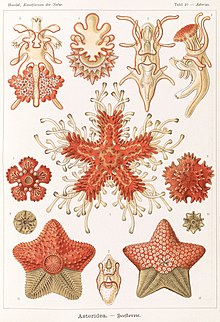
| |
| "Asteroidea" from Ernst Haeckel's Kunstformen der Natur, 1904 | |
| Scientific classification | |
| Kingdom: | |
| Phylum: | |
| Subphylum: | |
| Class: | Asteroidea
|
| Orders | |
|
Brisingida (100 species[1]) | |
Sea stars (also often called "starfish") are echinoderms belonging to the class Asteroidea[2]. The names "sea star" and "starfish" are sometimes differentiated,[3] with "starfish" used in a broader sense to include the closely related brittle stars, which make up the class Ophiuroidea, as well as excluding sea stars which do not have exactly five arms, such as the sun stars and cushion stars.
Sea stars exhibit a superficially radial symmetry. They typically have five "arms" which radiate from a central disk (pentaradial symmetry). However, the evolutionary ancestors of echinoderms are believed to have had bilateral symmetry. Sea stars do exhibit some superficial remnant of this body structure, evident in their larval pluteus forms.[4]
Sea stars do not rely on a jointed, movable skeleton for support and locomotion (although they are protected by their skeleton), but instead possess a hydraulic water vascular system that aids in locomotion.[5] The water vascular system has many projections called tube feet on the ventral face of the sea star's arms which function in locomotion and aid with feeding. Sea stars usually hunt for shelled animals such as oysters and clams. They have two stomachs. One stomach is used for digestion, and the second stomach can be extended outward to engulf and digest prey. This feature allows the sea star to hunt prey that is much larger than its mouth would otherwise allow. Sea stars are able to regenerate lost arms. A new sea star may be regenerated from a single arm attached to a portion of the central disk.[6]
External anatomy


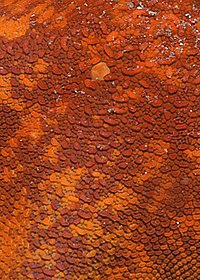
Sea stars are composed of a central disc from which arms sprout in pentaradial symmetry. Most sea star have 5 arms, but some have more or fewer. Some sea stars have shown differing numbers of limbs within a single species. [7]
The mouth is located underneath the sea star, on its ventral surface. The spiny upper surface is called the aboral or dorsal surface. On the aboral surface there is a structure called the madreporite, a small white spot located slightly off-center on the central disc which acts as a water filter and supplies the sea star's water vascular system with water to move. Porcellanasteridae employ additional cribriform organs used to generate current in the burrows made by these infaunal sea star.[8]
While having their own basic body plan, sea stars radiate diversely in shapes and colors, the morphology differing between each species. A sea star may have dense rows of spines as a means of protection, or it may have no spines at all. Starfish range from nearly pentagonal (example: Indo-pacific cushion star, Culcita novaeguineae) to gracile stars like those of the Zoroaster genus.
Surrounding the spines on the surface of the sea star are small white objects known as pedicellariae. There are large numbers of these pedicellariae on the external body which serve to prevent encrusting organisms from colonizing the sea star. [9]The radial canal which is across each arm of the sea star has tooth-like structures called ampullae, which surround the radial canal.
On the end of each arm or ray there is a microscopic eye (ocellus)which allows the sea star to see, although it only allows it to see light and dark, which is useful to see movement.[10] Only part of the cells are pigmented (thus a red or black color) and there is no cornea or iris. This eye is known as a pigment spot ocellus.[11]
Patterns including mosaic-like tiles formed by ossicles, stripes, interconnecting net between spines, pustules with bright colors, mottles or spots. These mainly serve as camouflage or warning coloration which is displayed by many marine animals as a means of protection against predation. Several types of toxins and secondary metabolites have been extracted from several species of sea star. Research into the efficacy of these compounds for possible pharmacological or industrial use occurs worldwide.
Internal anatomy
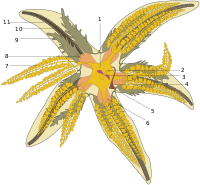
The body cavity also contains the water vascular system that operates the tube feet, and the circulatory system, also called the hemal system. Hemal channels form rings around the mouth (the oral hemal ring), closer to the top of the sea star and around the digestive system (the gastric hemal ring).[12] A portion of the body cavity called the axial sinus connects the three rings. Each ray also has hemal channels running next to the gonads.
Digestion and excretion
Sea star digestion is carried out in two stomachs in the mouth: the cardiac stomach and the pyloric stomach. The cardiac stomach is a sack like stomach located at the center of the body and may be everted out of the organism's body to engulf and digest food.[13] Some species are able to use their water vascular systems to force open the shells of bivalve mollusks such as clams and mussels by injecting their stomachs into the shells. With the stomach inserted inside the shell, the sea star is able to digest the mollusk in place. The cardiac stomach is then brought back inside the body, and the partially digested food is moved to the pyloric stomach.[14] Further digestion occurs in the intestine. Waste is excreted through the anus on the aboral side of the body.[15]
Because of this ability to digest food outside of its body, the sea star is able to hunt prey that are much larger than its mouth would otherwise allow, such as clams and oysters, arthropods, small fish, and mollusks.
Some echinoderms live several weeks without food under artificial conditions. It is believed that they may receive some nutrients from organic material dissolved in seawater.
Sea stars and other echinoderms have endoskeletons, suggesting that echinoderms are very closely related to chordates; animals with a hollow nerve chord that usually have vertebrae.
Variety

As mentioned above there are over 1800 species; many others probably remain undiscovered. Some of the better known sea star include:
- Blue sea star
- Carpet sea star
- Comb sea star
- Common starfish
- Crown-of-thorns sea star
- Eleven-armed sea star
- Japanese sea star
- Ochre sea star
- Pincushion sea star
- Pink sea star
A Japanese variety known locally as gohongaze is considered an edible delicacy[16].
Physiology
Nervous system
Echinoderms have rather complex nervous systems, but lack a true centralized brain. All echinoderms have a network of interlacing nerves called a nerve plexus which lies within as well as below the skin.[17] The esophagus is also surrounded by a number of nerve rings which send radial nerves that are often parallel with the branches of the water vascular system. The ring nerves and radial nerves coordinate the sea star's balance and directional systems. Although the echinoderms do not have many well-defined sensory inputs, they are sensitive to touch, light, temperature, orientation, and the status of water around them.[18] The tube feet, spines, and pedicellariae found on sea stars are sensitive to touch, while eyespots on the ends of the rays are light-sensitive.[19] The tube feet, especially those at the tips of the rays, are also sensitive to chemicals and this sensitivity is used in locating odor sources, such as food.[20]
Diet

Most species are generalist predators, eating mollusks such clams, oysters, some snails, or any other animal too slow to evade the attack (e.g. other echinoderms, or dying fish). Some species are detritivores, eating decomposed animal and plant material or organic films attached to substrate. Others may consume coral polyps (the best-known example for this is the infamous Acanthaster planci), sponges or even suspended particles and plankton (such as sea stars of the Order Brisingida).[21] The processes of feeding and capture may be aided by special parts; Pisaster brevispinus or short-spined pisaster from the West Coast of America may use a set of specialized tube feet to extend itself deep into the soft substrata to extract prey (usually clams)[22]. Grasping the shellfish, the sea star slowly pries open the shell by wearing out the adductor muscle and then inserts (also called evisceration) its stomach into an opening to devour the organism.
Reproduction
Sea stars are capable of both sexual and asexual reproduction. Individual sea stars are male or female. Fertilization takes place externally, both male and female releasing their gametes into the environment. Resulting fertilized embryos form part of the zooplankton.
Sea stars are developmentally (embryologically) known as deuterostomes. Their embryo initially develops bilateral symmetry, indicating that sea stars probably share a common ancestor with the chordates, which includes the fish. Later development takes a very different path however as the developing star fish settles out of the zooplankton and develops the characteristic radial symmetry. Some species reproduce cooperatively, using environmental signals to coordinate the timing of gamete release; in other species, one to one pairing is the norm.
Sea stars commonly reproduce by free-spawning: releasing their gametes into the water where they hopefully are fertilized by gametes from the opposite sex. To increase their chances of fertilization, sea stars probably gather in groups when they are ready to spawn, use environmental signals to coordinate timing (day length to indicate the correct time of the year, dawn or dusk to indicate the correct time of day), and may use chemical signals to indicate their readiness to each other. [23]
Fertilized eggs grow into bipinnaria and later into brachiolaria larvae, which either grow using a yolk or by catching and eating other plankton. In either case, they live as plankton, suspended in the water and swimming by using beating cilia. The larvae are bilaterally symmetric — unlike adults, they have a distinct left and right side. Eventually, they undergo a complete metamorphosis, settle to the bottom, and grow into adults.Some species of sea star brood their young: the males spawn gametes which fertilize eggs held by the females. The females may hold the eggs on their surface, in the pyloric stomach (as in Leptasterias tenera), or even attach them to the ground (as in Asterina gibbosa). Brooding is especially common in polar and deep-sea species, environments less favourable for larvae.
Male and female sea stars are not distinguishable from the outside; one needs to see the gonads or be lucky enough to catch them spawning. The gonads are located in each arm, and release gametes through gonoducts located on the central body between the arms.
Some species of sea star also reproduce asexually by fragmentation, often with part of an arm becoming detached and eventually developing into an independent individual sea star. This has led to some notoriety. Sea stars can be pests to fishermen who make their living on the capture of clams and other mollusks at sea as sea stars prey on these. The fishermen would presumably kill the sea stars by chopping them up and disposing of them at sea, ultimately leading to their increased numbers until the issue was better understood. A sea-star arm can only regenerate into a whole new organism if some of the central ring of the sea star is part of the chopped off arm.
Locomotion

Sea stars move using a water vascular system. Water comes into the system via the madreporite. It is then circulated from the stone canal to the ring canal and into the radial canals. The radial canals carry water to the ampullae and provide suction to the tube feet. The tube feet latch on to surfaces and move in a wave, with one body section attaching to the surfaces as another releases. Most sea stars cannot move quickly. However, some burrowing species from the genera Astropecten and Luidia are capable of rapid, creeping motion: "gliding" across the ocean floor. This motion results from their pointed tubefeet adapted specially for excavating patches of sand.
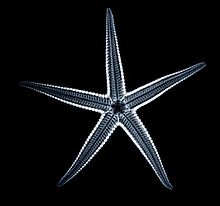
Regeneration
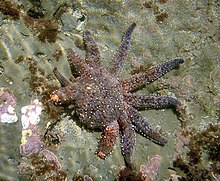
Some species of sea star have the ability to regenerate lost arms and can regrow an entire new arm in time. Most species must have the central part of the body intact to be able to regenerate, but a few can grow an entire sea star from a single ray. Included in this group are the red and blue Linckia star. The regeneration of these stars is possible due to the vital organs kept in their rays.[24]
Larval development
The larvae of echinoderms are ciliated, free-swimming organisms. They tend to look like embryonic chordates because they organize themselves bilaterally. As the organism grows, one side of the body grows more than the other, and eventually absorbs the smaller side. After that, the body is formed into five parts around a central axis. Then the echinoderm has radial symmetry.
Distribution
There are about 1,800 known living species of sea star, and they occur in all of the Earth's oceans. The greatest variety of sea stars is found in the tropical Indo-Pacific. Areas known for their great diversity include the tropical-temperate regions around Australia, the tropical East Pacific, and the cold-temperate water of the North Pacific (California to Alaska). Asterias is a common genus found in European waters and on the eastern coast of the United States; Pisaster, along with Dermasterias ("leather star"), are usually found on the western coast. Habitats range from tropical coral reefs, kelp forests to deep-sea floor, although none of them live within the water column; all species of sea star found are living as benthos. Echinoderms need a delicate internal balance in their body; no sea stars are found in freshwater environments.
Notes
- ^ a b c d e f g Sweet, Elizabeth (2005-11-22). "Asterozoa: Fossil groups: SciComms 05-06: Earth Sciences". Retrieved 2008-05-07.
- ^ Mooi, Rich. "Classification of the Extant Echinodermata." California Academy of Sciences - Research. <http://research.calacademy.org/research/izg/echinoderm/classify.htm>.
- ^ "Starfish (Sea Star), Starfish (Sea Star) Profile, Facts, Information, Photos, Pictures, Sounds, Habitats, Reports, News - National Geographic." Animals - Facts, Information, Photos, Pictures, Sounds, Habitats, Reports, News - National Geographic. 2008. <http://animals.nationalgeographic.com/animals/invertebrates/starfish.html>.
- ^ "Starfish." 16 May 2008. HowStuffWorks.com. <http://animals.howstuffworks.com/marine-life/starfish-info.htm> 16 January 2009.
- ^ "Wonders of the Sea: Echinoderms." Ceanside Meadows Institute for the Arts and Sciences. <http://www.oceaninn.com/guides/echino.htm>.
- ^ Farrerree, James W. "SeaStars." Wetwebmedia, Aquarium, Pond, Marine and Freshwater Fish, reef tanks, and Aquatics Information. <http://www.wetwebmedia.com/seastars.htm>.
- ^ Dale, Jonathan. "Why do starfish always have five rays?" Madreporite Nexus. 24 May 2009. <http://www.madreporite.com/science/fiverays.htm>.
- ^ Star Fish." South Central Service Co-op. 2001. <http://www.scsc.k12.ar.us/2001Outwest/PacificNaturalHistory/Projects/ReynoldsJ/Default.htm>.
- ^ Jon, Antoine M. "Animalia Echinodermata." BIODIDAC: A bank of digital resources for teaching biology. <http://biodidac.bio.uottawa.ca/thumbnails/filedet.htm?File_name=ECHI013B&File_type=CDR>.
- ^ "Animal Eyes." San Diego Natural History Museum--Your Nature Connection in Balboa Park. 31 Dec. 2002. <http://www.sdnhm.org/exhibits/eyes/overview.html>.
- ^ "Eye (invertebrate)" McGraw-Hill Encyclopedia of Science & Technology, vol. 6, p.790 2007
- ^ "Sea stars on Chek Jawa, Pulau Ubin, Singapore." Wildsingapore. <http://www.wildsingapore.org/chekjawa/text/p610.htm>.
- ^ "Marine Biology Echinodermata - Sea Star." <http://home.earthlink.net/~huskertomkat/star.html>.
- ^ Nicholson, F. C. "How a Sea Star Gets Its Clam - Science Stories - HighlightsKids.com." HighlightsKids. <http://www.highlightskids.com/Science/Stories/SS0596_howseastargetsclam.asp>.
- ^ Dale, Jonathan. "Starfish Digestion and Circulation." 24 May 2009. Madreporite Nexus. <http://www.madreporite.com/science/digest.htm>.
- ^ "Cooking Starfish In Japan". Retrieved 2008-05-07.
- ^ "Star Fish." South Central Service Co-op. 2001. <http://www.scsc.k12.ar.us/2001Outwest/PacificNaturalHistory/Projects/ReynoldsJ/Default.htm>.
- ^ "Starfish brains, night length, space radiation." WonderQuest. 18 Apr. 2008. <http://www.wonderquest.com/sea-stars-nights-space-radiation.htm>.
- ^ Dale, Jonathan. "The Starfish Nervous System." Madreporite Nexus. 24 May 2009. <http://www.madreporite.com/science/fiverays.htm>.
- ^ Dale, Jonathan. "The Starfish Nervous System." Madreporite Nexus. 24 May 2009. <http://www.madreporite.com/science/orientation.htm>.
- ^ Dale, Jonathan. "Starfish Ecology." Madreporite Nexus. 24 May 2009. <http://www.madreporite.com/science/ecology.htm>.
- ^ Nybakken Marine Biology: An Ecological Approach, Fourth Edition, page 174. Addison-Wesley Educational Publishers Inc., 1997.
- ^ Chaet, Alfred B., American Zoologist 1966 6(2):263-271, "The Gamete-Shedding Substances of Starfishes: A Physiological-Biochemical Study" http://icb.oxfordjournals.org/cgi/content/abstract/6/2/263
- ^ Dale, Jonathan. "Starfish Regeneration." Madreporite Nexus. 24 May 2009. <http://www.madreporite.com/science/regeneration.htm>.
References
- Blake DB, Guensburg TE; Implications of a new early Ordovician asteroid (Echinodermata) for the phylogeny of Asterozoans; Journal of Paleontology, 79 (2): 395-399; MAR 2005.
- Gilbertson, Lance; Zoology Lab Manual; McGraw Hill Companies, New York; ISBN 0-07-237716-X (fourth edition, 1999).
- Shackleton, Juliette D.; Skeletal homologies, phylogeny and classification of the earliest asterozoan echinoderms; Journal of Systematic Palaeontology; 3 (1): 29-114; March 2005.
- Solomon, E.P., Berg, L.R., Martin, D.W. 2002. Biology, Sixth Edition.
- Sutton MD, Briggs DEG, Siveter DJ, Siveter DJ, Gladwell DJ; A starfish with three-dimensionally preserved soft parts from the Silurian of England; Proceedings of the Royal Society B - Biological Sciences; 272 (1567): 1001-1006; MAY 22 2005.
- Hickman C.P, Roberts L.S, Larson A., l'Anson H., Eisenhour D.J.; Integrated Principles of Zoology; McGraw Hill; New York; ISBN 0-07-111593-5 (Thirteenth edition; 2006).
External links
- From the Tree of Life project
- Classification of the Extant Echinodermata
- Starfish–Sea Stars Home Page
- Starfish Population Explosion
- Photos of Sea Stars
- Photographic Database of Cambodian Sea Star Species
Gallery
-
Large red starfish found in Komodo National Park, Indonesia.
-
Sea star from Komodo National Park, Indonesia.
-
Crown of thorns starfish from East Timor.
-
Blue starfish in Papua New Guinea.
-
Bat star, Asterina miniata.
-
Ochre sea star, Pisaster ochraceus, on beach at Olympic National Park, USA.
-
Pisaster giganteus, the giant sea star.
-
The tube feet can be seen on this starfish.
-
Caribbean seastar (Oreaster reticulatus), Bahia de la Chiva, Vieques, PR.














